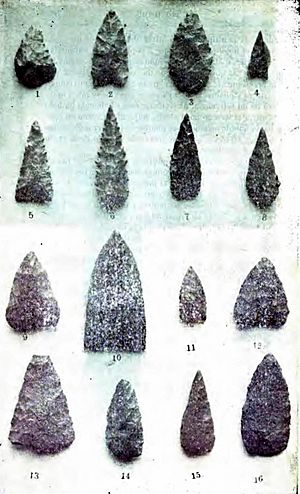Promaucae facts for kids
The Promaucae (pronounced Pro-mow-kah-ay) were a brave group of Mapuche people who lived a long time ago in what is now Chile. Their name comes from a Quechua word, purum awqa, which means "wild enemy." This name was given to them by the Inca because the Promaucae successfully defended their land. They lived south of the Maipo River near Santiago, Chile and stretched down to the Itata River. Like other Mapuche groups, they spoke Mapudungun. The Spanish later called them Purumaucas or Promaucaes.
Who Were the Promaucae?

The Inca called any people not under their rule puruma auca. The Promaucae were part of the Picunche tribe, who lived north of the Itata River. They earned their special name after successfully defending their land from the Inca Empire in the Battle of the Maule.
The Promaucae were the first people in the Rancagua Valley that we have historical records about. The Mapuche people knew them as picunche, which means "people of the north." The Promaucae were a unique group. They were different from other Picunche who lived north of the Maipo (called mapochoes) and those south of the Maule (called maules and cauquenes). The Inca invaders noticed how strong and determined the Promaucae were in battle.
These people were skilled farmers. They built special earthworks to help water their crops. We also know about them from the pottery they left behind.
Facing the Inca Empire
The Inca Empire was always expanding. They used a fort called Pucara del Cerro La Muralla to help them. This fort was the southernmost Inca settlement known at that time. Inca expeditions into this area were led by Túpac Inca Yupanqui in the late 1400s. Later, Huayna Cápac also led expeditions.
Most of what we know about this time comes from old stories written down later. These stories say that the Promaucae heard the Inca were coming. They teamed up with other groups like the Antalli, Pincu, and Cauqui. Together, they formed a large army of 20,000 warriors.
The Inca sent messengers to try and convince the Promaucae to accept Túpac Inca Yupanqui as their ruler. But the Promaucae decided to fight. This led to a big battle known as the Battle of the Maule. Both sides lost many soldiers, and neither army won a clear victory.
For the next two days, neither army left their fortified camps. They were ready to defend if the other side attacked. The fifth and sixth days were the same. But on the seventh day, the Promaucae and their allies left. They went home, saying they had won. The Inca thought about chasing them, but decided to secure the land they had already conquered. Túpac Inca Yupanqui agreed with this plan.
Because they lived close to the Inca Empire, the Promaucae learned new technologies from the Inca.
Promaucae Regions
The Spanish used the Inca term "Promaucae" to describe several groups. This included the people living in the Rapel River valley. Those in the Mataquito River valley were called the Cure. This is why the province of Curicó is named after them. People in the Maule River valley and to the south were known as Maule. South of the Maule and north of the Itata River, people were called Cauqui by the Inca, or Cauquene. The Spanish later named the Cauquenes River after them.
See also
 In Spanish: Promaucaes para niños
In Spanish: Promaucaes para niños

